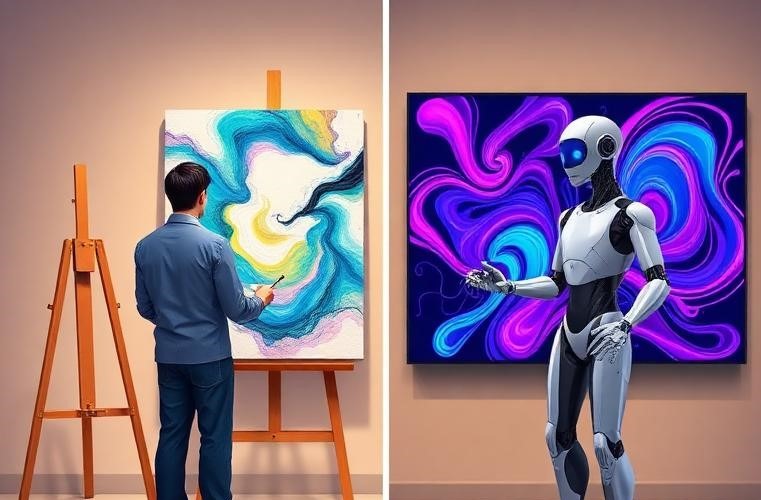The ( Evolution of Human-Computer Interaction ) Shaping the Future of Connectivity World. In the earlier days of human-computer interaction (HCI), there was the more conventional option of a keyboard and mouse to work with.
These days, technologies develop in whimsical upgrades of how we transmit digital messages between us, people, and machines. Below are the key successes achieved as the result of the ‘these particular journey’.
1. Natural User Interface (NUI)
NUIs focus on making technology interplay a lot of instinctive and naturally. Touch screens, voice recognition, and gesture control represent a shift toward interfaces that mimic human communication patterns.
Digital items like smartphones and smart speakers as well as the NUIs have penetrated the wide spectrum of user vacancy possibilities. Speaking with the devices makes them also more natural and less forced.
2. Voice-Activated Assistants Involve in HCI
The rise of voice-activated command assistants like Alexa, Siri, and Google Assistant has perfectly changed how we interact with smart devices. Users can now do tasks, ask questions, manage other commands, and control smart home devices with their natural languages.
With the fast pace progression in natural language processing as well as speech recognition technologies the functionality of the voice-operated interfaces improves in terms of accuracy and responsiveness. Voice-activated assistants made Human Life Much Easier. It is the best Example Of HCI how Human-Computer Interaction is going to innovate.
3. Immersive Technology Experiences with VR and AR
Virtual Reality (VR) and Augmented Reality (AR) technologies have created a disruptive change in user experience and the proliferation of immersive interfaces that let the physical and virtual worlds be linked together. VR delivers a virtually genuine environment, but AR takes information from digital sources and superimposes it on the real world.
The world of art and design has been transformed with the use of VR and AR, as has the way we get information. For example, gaming and education are now brought into a third dimension, while healthcare and design are becoming more engaging. VR & AR work perfectly for humans to see anything anywhere that’s HCI. Read More: What is Immersive Technology (AR), (VR) & (MR) 3 Realities?
4. Brain-Computer Interface (BCI)
BCI is at the forefront of future interfaces, allowing direct communication between the brain and computer. Electroencephalography (EEG) and more neuroimaging technologies enable users to manage & control smart devices easily with their thoughts/thinks.
BCI is already in the budding stages. Being a new technology, it has so many prospects for the disabled and is useful in various areas of improving interactions between humans and computers.
5. Tactile Feedback and Haptics
Practically, the addition of palpable feedback and tactile devices in games increases the digital experience by bringing a sense of touch to the digital interactions. This implies a mixture of sensations like vibrations, force feedback, and also even a temperature change.
From gaming sticks to screens, touch-based manipulation boosts the quality of the interaction by not only making it more realistic but also packed with sensuality whereby a user derives their senses.
6. Wearable Technology
Wearable gadgets, like smartwatches and fitness trackers, are a move toward tech that fits so well into our daily routine that we don’t notice it is only digital. This technology does not only embrace interface convenience and real-time information updates but also builds and improves research through the data shared by the user.The integration of health monitoring features, notifications, and smart assistant capabilities makes wearables a central component of the emerging HCI landscape.
7. Identification of Signals
Gesture recognition use in technology enables users to connect with devices & commands through hand movements, slides, and gestures. This intuitive interface has applications in gaming, music, torches, cameras, smart TVs, and public displays.
The continuous evolution of cameras and sensors gives a chance for devices to rightly catch and reply to various prompts, which helps to increase the sense of natural interaction of a user with the device.
8. Biometric Authentication
Biometric methods of authentication, such as fingerprint scanning, facial recognition, privacy safety, and iris scanning, are becoming essential to user better interfaces.
This includes such processes as NFC, 2-factor authentication, and biometric analysis, which guarantee security, protection, and control of your smart devices and personal information. Seamless integration of biometric authentication enhances the overall user experience by reducing reliance on traditional passwords.
Technology continues to advance, and the future of HCI holds thrilling possibilities. From brain-computer interfaces to immersive realities, the emerging landscape promises interfaces that are not just tools but seamless extensions of human capabilities, fostering a more integrated and interactive digital age.
9. Emotionally Intelligent Interface
Moreover, the HCI future features the interface that translates, and thus, processes the data reflecting a person’s good emotional condition. Rather than just, emotional intelligence systems that use facial recognition, voice tone analysis, and biometric data to see user emotions and tailor interactions as needed are some and many.
The objective of this movement is to thereby design more empathetic and responsive technology products that eventually make the lives of humans better by providing better virtual customer services, mental health applications, and personalized content delivery.
10. Local Computing
Spatial computing is an extension of the environment, where the real world acts as a medium for getting in touch with digital content. This comprises putting together mixed reality and spatial mapping technology, with users hardening to manipulate digital information just in their physical setting.The digital and physical structuring of real space technology in spatial computing broadens the horizons for the presentation of data, design co-creation, and immersive storytelling.
11. Intelligent Automation and Predictive Interface
The term “intelligent automation” stands for the use of systems based on machine learning technology, which learn by themselves from user behavior and automate repetitive activities.Thus, this streamlines the overall workflow. prophesy interfaces imply that AI algorithms should have enough predictiveness to meet users’ requirements and technological advances will give relevant context tips.
These interfaces consider the brain function by doing away with time-consuming and repetitive decisions and exposing only the information, which is useful for the users to pay attention to the more complex and interesting aspects of any interchange.
12. Multimodal Interface
Multimodal interfaces represent two modes of interaction like touch, voice, and gesture, which allow the user to transpire a smooth and flexible experience. These mediators are aware of the fact that users are often looking for different ways of interrelating with each other when in varying environments.
In the same way, a smart home system might let the users control lights by giving out commands through voice and also adjusting the temperature either through tactile gestures or visual indicators this way an interface that will support a wide variety of controls is created. provides.
13. Continuous Connectivity with the Internet of Things (IoT)
Widespread IoT devices do bring an advanced level of integration into the HCI ecosystem. Not only from smart kitchen appliances to industrial sensors the capacity of smart devices to connect with others easily allows them to do their job better leading to enhanced user experience and professional handling of the system. IoT is more connected to HCI, some times they work together, and HCI is Connected to various corners.
Connected devices construct a net of surrounding messages that can even deliver more personalized and labor-efficient services. As such, smart thermostats can be programmed to take into consideration both user preferences and real-time environmental conditions for the sake of energy efficiency.
14. Ethical Design and Comprehensive Interface
With advancing HCI, more emphasis would be on the rightful designing approach and diversity. Taking into account the societal and ethical consequences of the user interface becomes more common among designers. They talk about algorithms’ bias, the need for equity in such interfaces, and users’ privacy.
Ethical design takes care that technology is user-friendly, ethical, and something that users can trust. It avoids exploiting workers and reproducing inequalities in society.
15. Adaptive Learning Interface
Through the use of machine learning algorithms adaptive learning interfaces aim to personalize the learning content by considering each learner’s style of studying, progress, and preferences. These interfaces create interfaces unique personalized learning experiences for each learner to fill their needs.
Such an approach rearranges the classical models of education by providing recommendations, adaptive feedback, and offering resources that are centered on the learner and more engaging to HCI.
16. Temporary Interface
The priority of temporal UIs is within the area of short-term and local interactions. This notion is especially relevant in the case of augmented reality experience where digital information is layered onto to physical sphere for a short period.
Thereby whether it be directions on city streets or information during a live event, imprecations as dials allow their ease of access without distracting the overall user experience.
17. Temporary Contacts
As time plays a crucial role in message delivery, temporal communication emphasizes time- and context-specific communication. This idea becomes significant in the augmented reality experience where the small scale of the physical space gets an extension with the digital information on it.
Whether local community messaging and mobile communications capability or instant access to digital information during an on-the-spot event or the real-time responses received, seamless communications deliver relevant information without affecting the user experience.
Conclusion
The rise of HCI is not only represented by the physical gadgets and interfaces where our daily contacts are being made, but it is just one of the multiple sides that surround this phenomenon.It covers transforming all the advanced systems into intelligent, smart, and ethical ones and merging them, so they can work in parallel with human beings in this kind of environment.
With the development of technology, that virtual machine that defines human-computer interaction has been turned into uncharted territory which is not only multiplying the number but also changing the nature of digital communication. Read More: What is Machine Learning? – A Beginner’s Guide
Comment your Thoughts/Queries Below






After study a few of the blog posts on your website now, and I truly like your way of blogging. I bookmarked it to my bookmark website list and will be checking back soon. Pls check out my web site as well and let me know what you think.
Hello There. I found your blog using msn. This is a very well written article. I will make sure to bookmark it and return to read more of your useful info. Thanks for the post. I will definitely comeback.
My partner and I stumbled over here from a different web page and thought I might check things out. I like what I see so now i’m following you. Look forward to exploring your web page repeatedly.
Very interesting topic, regards for posting.
Great website. Lots of useful info here. I’m sending it to several friends ans also sharing in delicious. And of course, thanks for your sweat!
Can you be more specific about the content of your article? After reading it, I still have some doubts. Hope you can help me.
Thank you for your sharing. I am worried that I lack creative ideas. It is your article that makes me full of hope. Thank you. But, I have a question, can you help me?
Hi there, just turned into aware of your blog thru Google, and found that it’s truly informative. I’m gonna be careful for brussels. I will be grateful for those who proceed this in future. Lots of folks can be benefited from your writing. Cheers!
Thank you for your sharing. I am worried that I lack creative ideas. It is your article that makes me full of hope. Thank you. But, I have a question, can you help me?
Thanks for sharing. I read many of your blog posts, cool, your blog is very good.
Your point of view caught my eye and was very interesting. Thanks. I have a question for you.
Your point of view caught my eye and was very interesting. Thanks. I have a question for you.
I have been absent for a while, but now I remember why I used to love this site. Thank you, I?¦ll try and check back more frequently. How frequently you update your web site?
Well I really liked studying it. This post procured by you is very constructive for accurate planning.
I am now not sure the place you’re getting your info, however good topic. I needs to spend some time learning much more or figuring out more. Thanks for magnificent info I was in search of this info for my mission.
I don’t think the title of your article matches the content lol. Just kidding, mainly because I had some doubts after reading the article.
Hello There. I found your blog using msn. This is a very well written article. I will be sure to bookmark it and return to read more of your useful information. Thanks for the post. I will certainly return.
Thank you for your sharing. I am worried that I lack creative ideas. It is your article that makes me full of hope. Thank you. But, I have a question, can you help me?
I always was concerned in this subject and still am, thankyou for posting.
I like this web blog very much, Its a very nice berth to read and find info . “There is no human problem which could not be solved if people would simply do as I advise.” by Gore Vidal.
I like this site because so much utile material on here : D.
It’s really a nice and helpful piece of information. I am glad that you shared this useful information with us. Please keep us up to date like this. Thanks for sharing.
Thanks for this marvellous post, I am glad I observed this web site on yahoo.
I am often to blogging and i really appreciate your content. The article has really peaks my interest. I am going to bookmark your site and keep checking for new information.
Your article helped me a lot, is there any more related content? Thanks!
Thanks for sharing. I read many of your blog posts, cool, your blog is very good.
My brother recommended I might like this website. He used to be entirely right. This post truly made my day. You can not believe simply how much time I had spent for this info! Thank you!
Reading your article has greatly helped me, and I agree with you. But I still have some questions. Can you help me? I will pay attention to your answer. thank you.
Heya i’m for the first time here. I found this board and I find It truly useful & it helped me out much. I hope to give something back and aid others like you aided me.
Thanks for sharing. I read many of your blog posts, cool, your blog is very good.